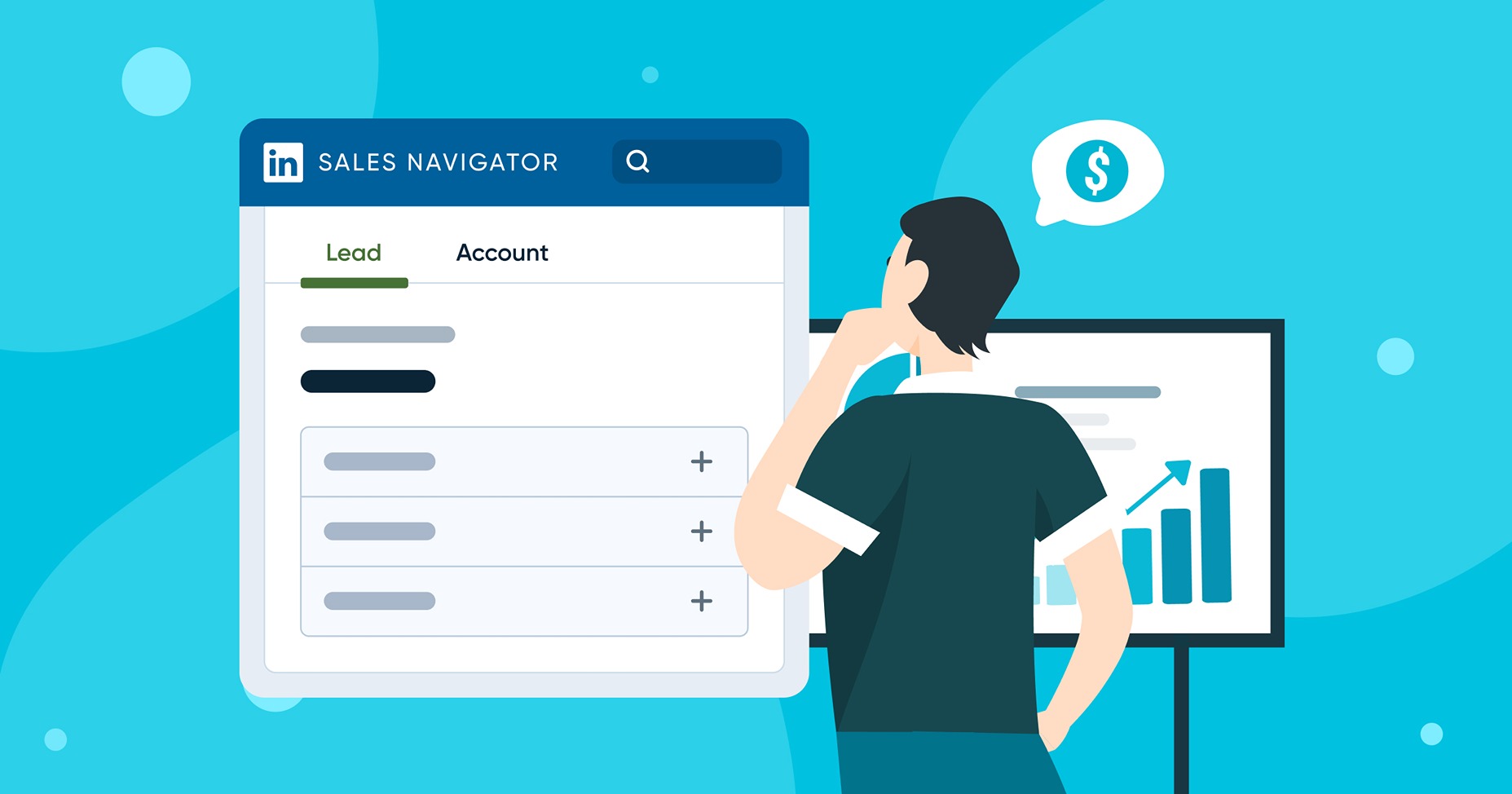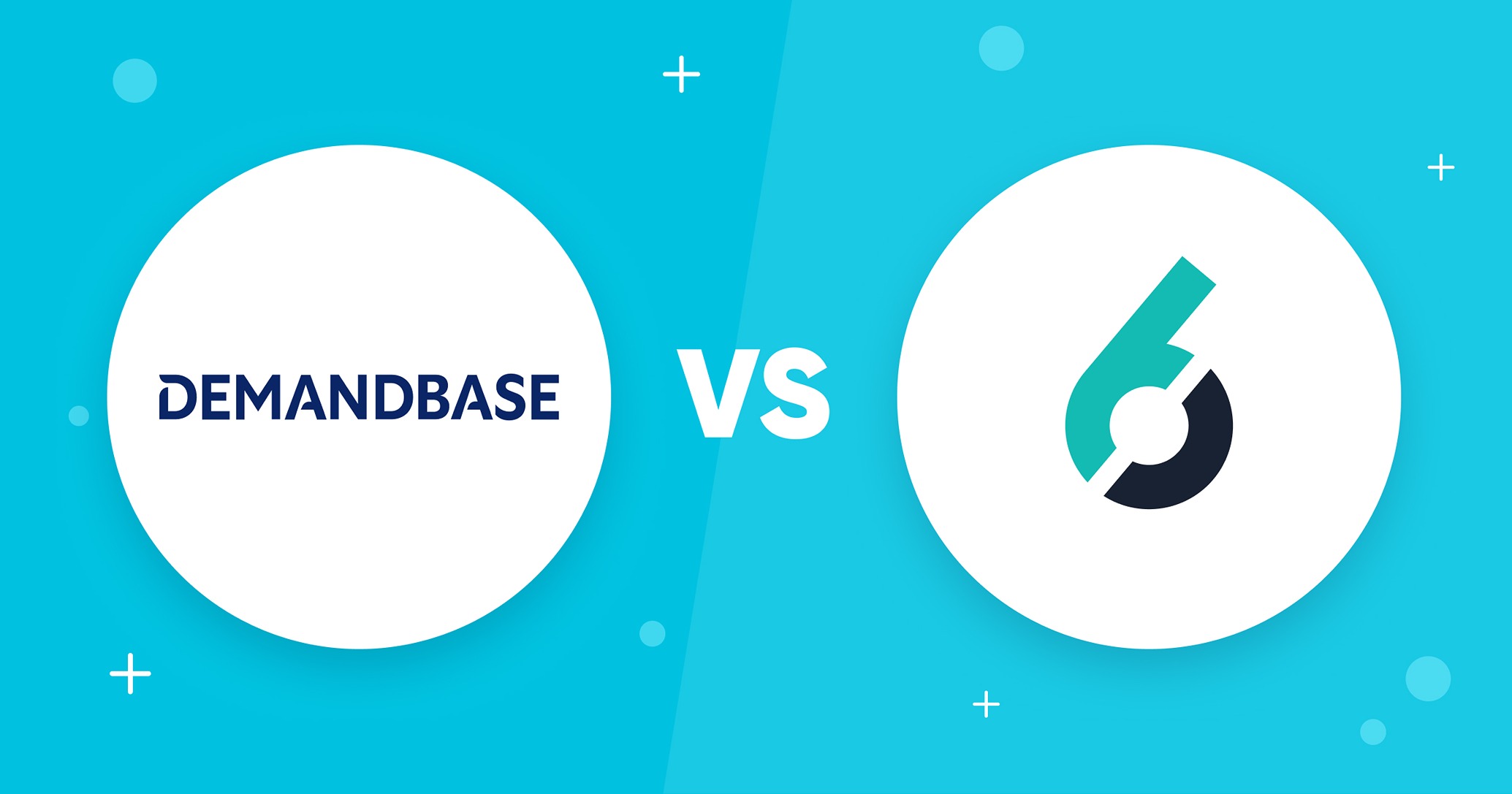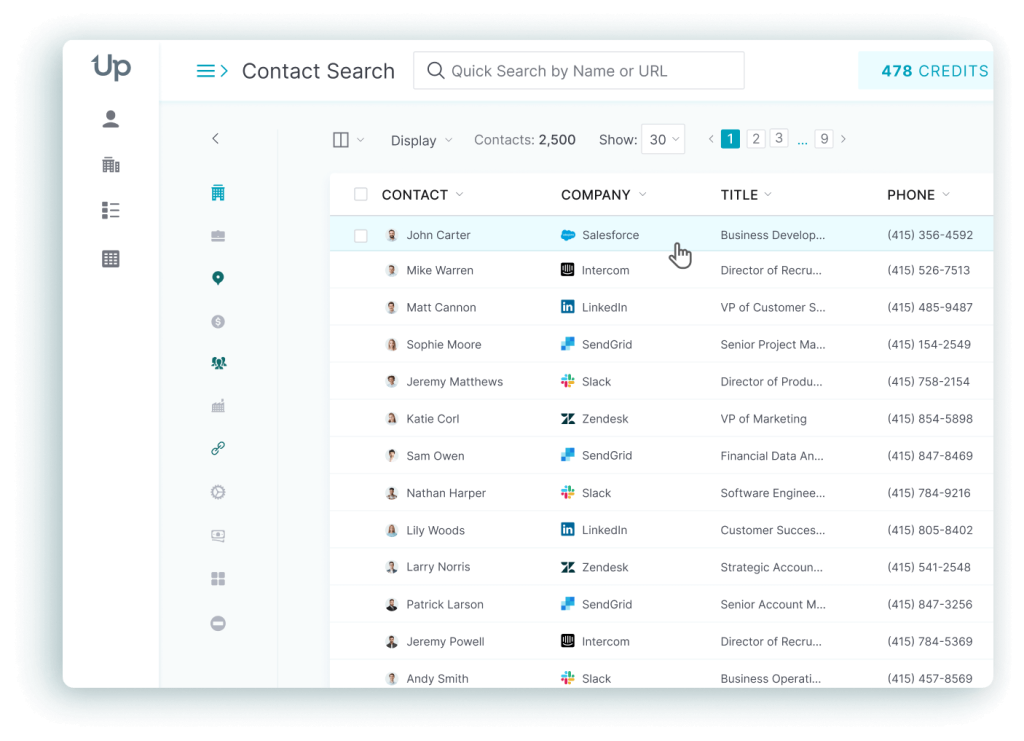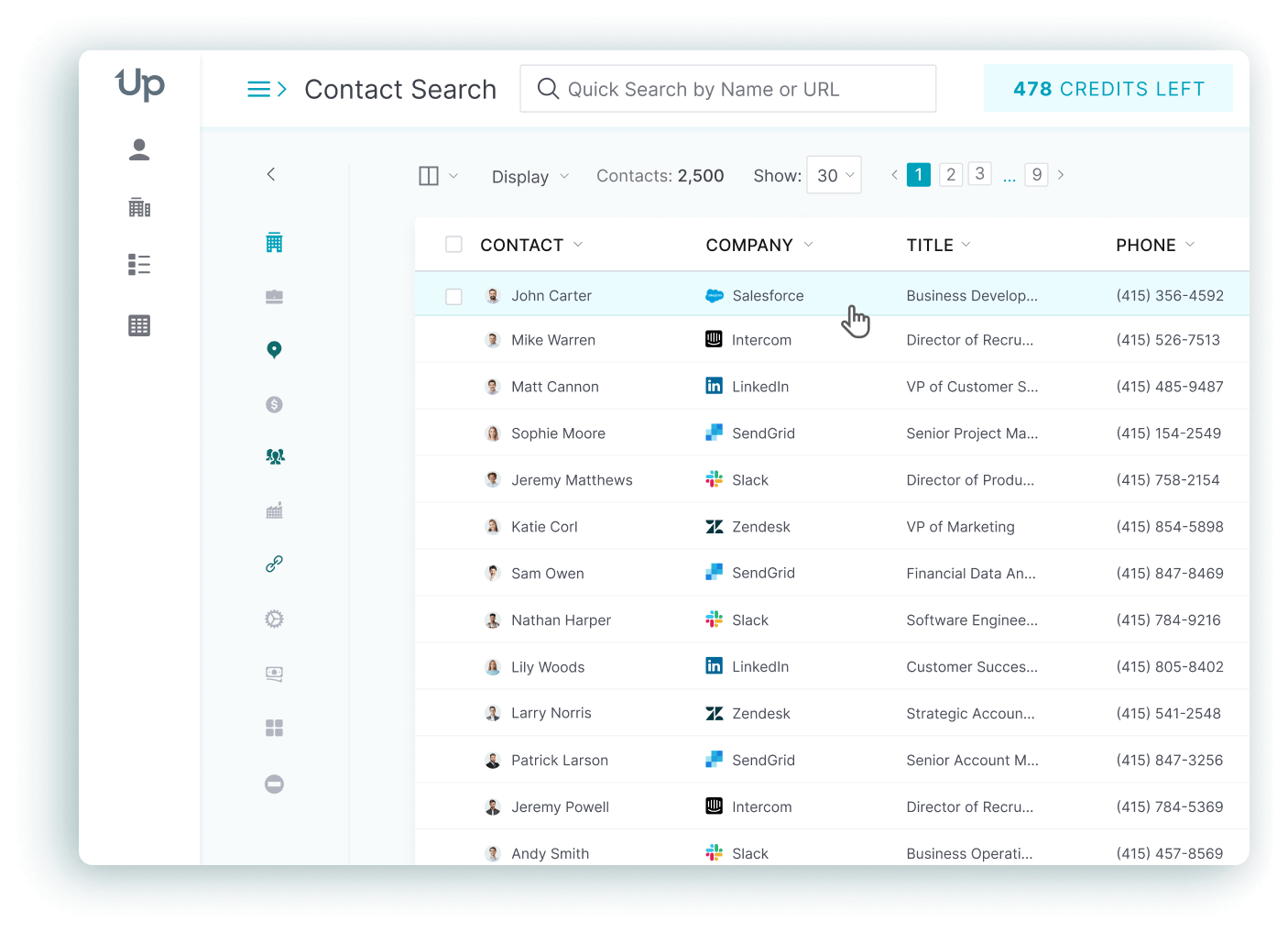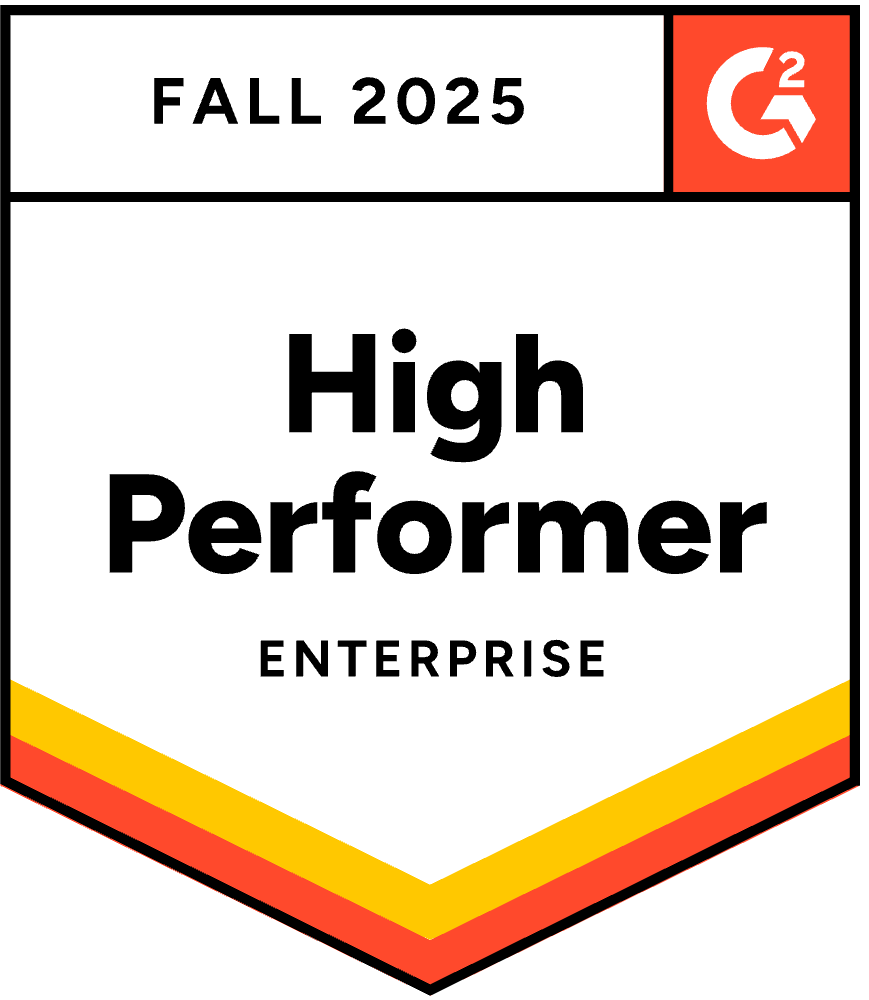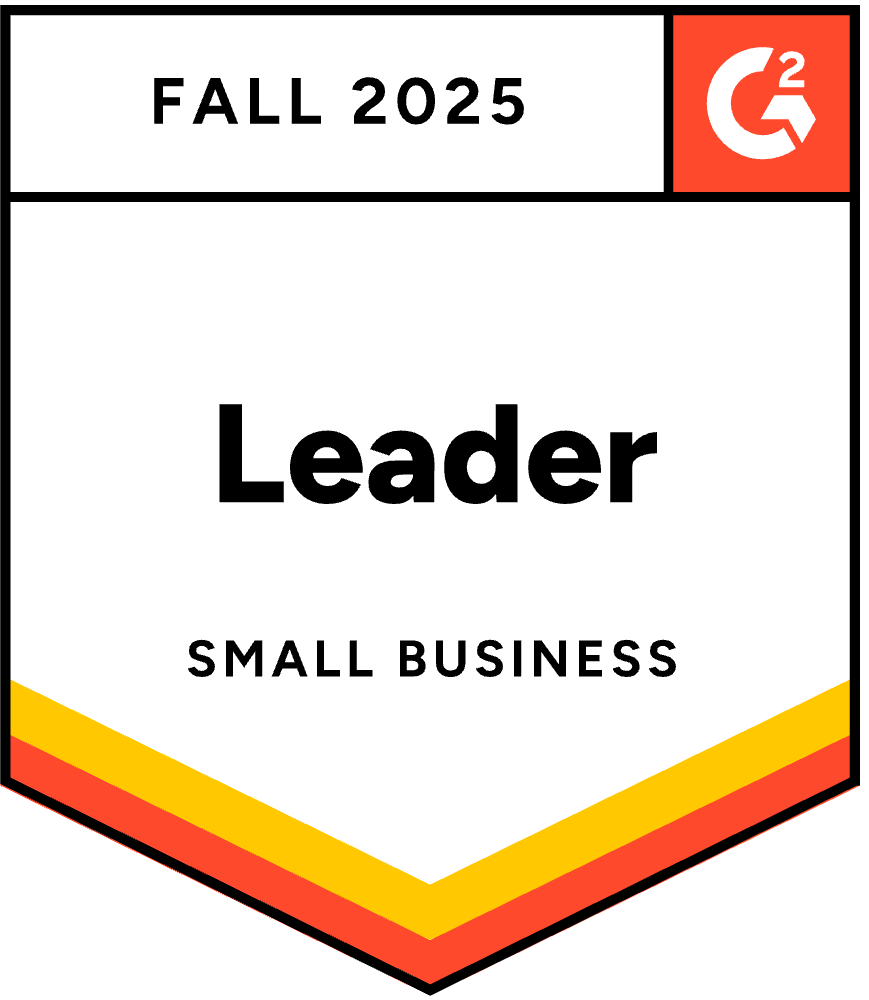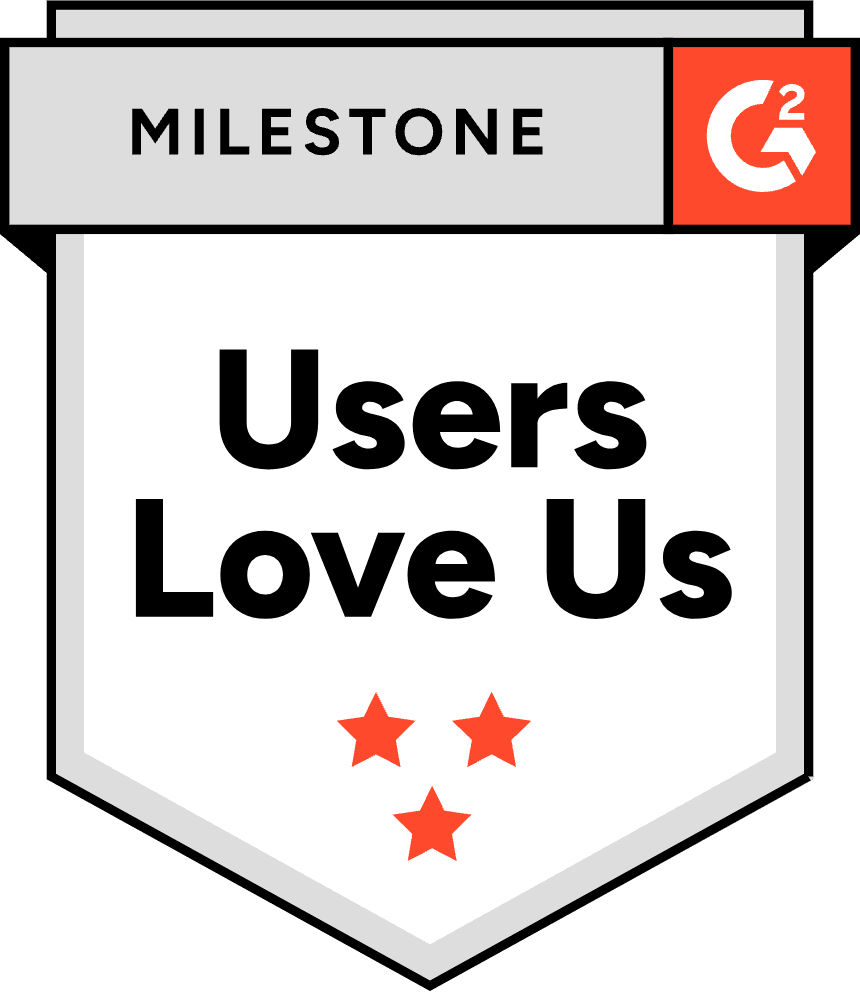Picking up the phone to call a stranger feels outdated and ineffective.
You face constant rejection, hit voicemails, and wonder if you’re just wasting your time while competitors close deals using modern methods.
Every “no” chips away at your confidence, and every hour spent dialing without a single meeting feels like a failure.
You know you need pipeline, but the fear of rejection and inefficiency is paralyzing.
But cold calling is far from dead. With 82% of buyers taking meetings from cold calls, the problem isn’t the channel. It’s the strategy.
This guide provides a complete, data-backed playbook for 2025, including legal guidelines, AI tools, and a step-by-step framework to turn cold calls from a source of fear into your most powerful pipeline generator.
📌 Reminder: You’ll only turn cold leads into red-hot sales opps if you’re approaching the right people and dialing active numbers. Our database of 160M+ contacts includes verified direct dials, giving our customers an edge in reaching the right people. Try UpLead and get 5 free credits!
What Is Cold Calling (and Is It Still Effective in 2025)?
Cold calling is a direct sales strategy where a salesperson contacts potential customers who have not previously shown interest in their product or service, typically via phone, to initiate a business relationship. Cold calling is a sales technique used by sales teams to reach out to prospects who have not expressed interest, aiming to engage them and build new business opportunities. Despite claims that it’s outdated, cold calling remains highly effective when executed strategically.
The numbers prove its continued relevance: 57% of C-suite executives and VPs prefer phone outreach over email or social media. The average cold calling success rate for booking meetings ranges from 2.3% to 4.82% in 2024-2025, with data provider Salesgenie reporting approximately 4.8% success rate as of 2024. While this might seem low, 51% of B2B leads still come from cold calling, and B2B cold calling campaigns can boost ROI by 40-50%.
The key insight is persistence: it takes an average of 6-8 attempts to reach a prospect, yet nearly half of salespeople give up after just one call. Cold calling can generate responses and gather valuable information within a short period, making it an efficient method for sales teams to quickly assess and qualify leads. This establishes why a strategic, data-driven approach is essential for cold calling success in 2025.
Is Cold Calling in the US Legal?
Cold calling in the US is legal but heavily regulated by the Telephone Consumer Protection Act (TCPA) and Telemarketing Sales Rule (TSR). Understanding these regulations protects you from fines up to $51,744 per call violation.
The TCPA restricts calls using Automatic Telephone Dialing Systems (ATDS) or prerecorded voices, requiring prior express written consent for marketing calls to cell phones. Call time restrictions apply nationwide: 8:00 AM to 9:00 PM local time of the recipient. Recent court rulings in April 2024 found that some platforms might be considered ATDS under the TCPA, increasing legal risk for users.
The National Do Not Call Registry allows consumers to opt out of telemarketing calls. While this primarily applies to B2C calls, with most B2B marketing calls exempt from federal DNC rules, companies must maintain internal ‘Do Not Call’ lists. Recent FTC amendments in March 2024 expanded the TSR to prohibit misrepresentations in all B2B telemarketing calls.
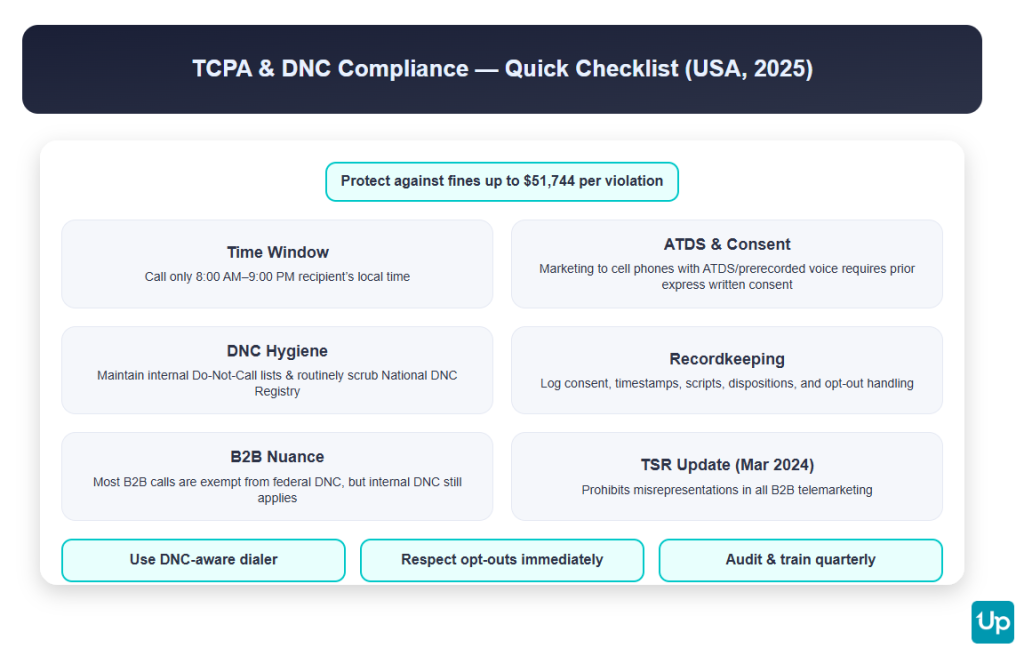
To stay compliant, use platforms that include DNC management features, respect call-time restrictions, maintain detailed records of consent, and regularly scrub your lists against the National DNC Registry.
What Are the Key Cold Calling Metrics to Track for Success?
Key cold calling metrics provide the data you need to improve performance and demonstrate ROI. Track these 6 essential KPIs to measure and optimize your cold calling efforts. Monitoring call volume and response rates enables your sales team to identify what works, refine their approach, and maximize the effectiveness of their cold calling strategy.
Making more cold calls increases call volume, provides valuable data, and helps sales teams improve their performance over time.
Connection Rate:
Percentage of calls resulting in human conversation. The benchmark averages around 4.8%, with top teams achieving over 30%. This metric reveals the quality of your data and timing.
Qualified Appointment Setting Rate:
Percentage of calls leading to scheduled meetings. Industry average sits around 2.5%, while top performers exceed 5.4%. This measures your ability to create interest and secure next steps.
Conversion Rate:
Percentage of calls or appointments resulting in closed deals. While call-to-sale conversion remains low (~2%), opportunity-to-deal win rate averages 27% in B2B sales.
Average Call Duration:
Successful B2B cold calls typically last 5-10 minutes for discovery calls, with data provider Salesgenie noting that successful initial calls typically last 2-3 minutes. Monitor your talk-to-listen ratio, aiming for 60:40.
Lead Quality Conversion:
Rate of cold-called leads becoming qualified pipeline opportunities. Strong programs convert at least 20% of contacted prospects into qualified leads.
Call Persistence Rate:
Average attempts per lead before connection or disqualification. Most prospects require 6-8 touchpoints, yet nearly half of reps give up after one call, missing significant opportunities.
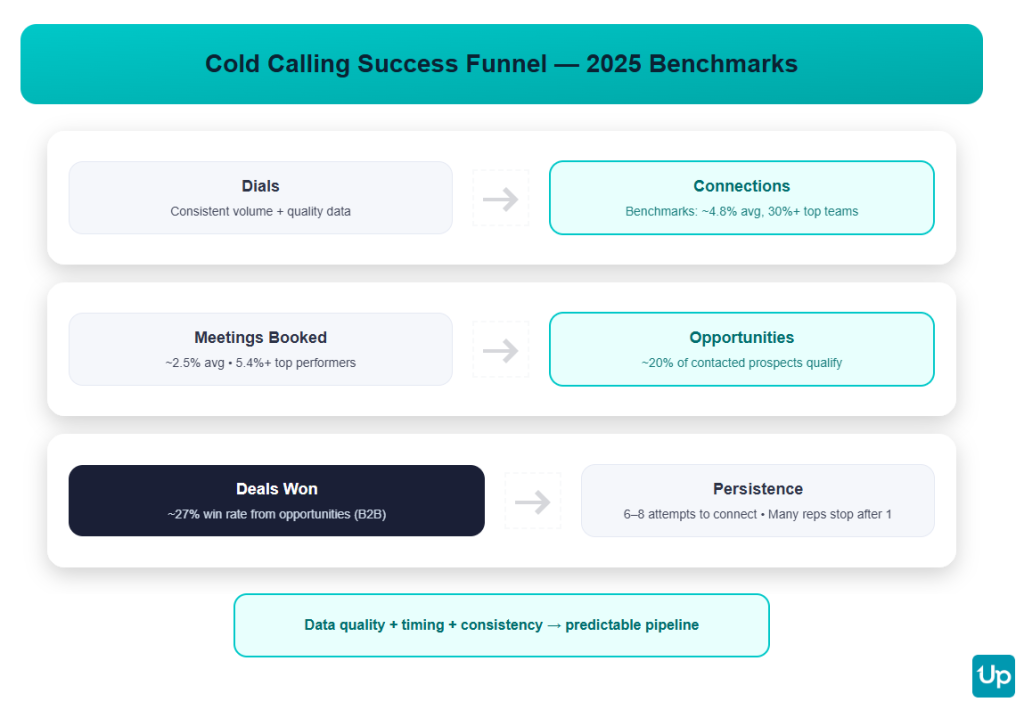
Before the Call – Preparation, Research & Mindset
Success in cold calling starts before you pick up the phone. Proper preparation, targeted research, and the right mindset create the foundation for effective conversations and higher conversion rates. Reviewing news articles and researching the prospect’s industry help you tailor your approach to their unique business environment. Identifying mutual connections can personalize your outreach and assist in building trust with the prospect. Understanding the prospect’s sales processes further builds credibility and trust, increasing your chances of a successful engagement.
Build a Targeted Prospect List
Building a targeted prospect list starts with defining your ideal customer profile (ICP) based on successful past customers. Use data platforms like UpLead to access over 160 million verified business contacts with 50+ filters including industry, company size, technology usage, and recent funding events.
Bad data means bad conversations. That’s exactly why we built UpLead. I spent years running a marketing agency buying data from every provider I could and the quality was brutal. We’d send lists to the Philippines just to verify numbers and still throw out a big chunk. It was expensive, slow, and killed momentum. That frustration is exactly why we built UpLead, so you can get clean, verified leads with mobile numbers instantly, without the hoops I had to jump through.
UpLead is the industry-leading sales intelligence platform that helps salespeople increase their sales by providing superior data quality and advanced search capabilities. Our platform makes it possible to build targeted lists of prospects from a database that has over 160 million business contacts with 95% email accuracy and real-time email verification.
You can search through our database using our comprehensive range of parameters, and our clean, verified data will help you connect with prospects and close more sales faster than any competitor.
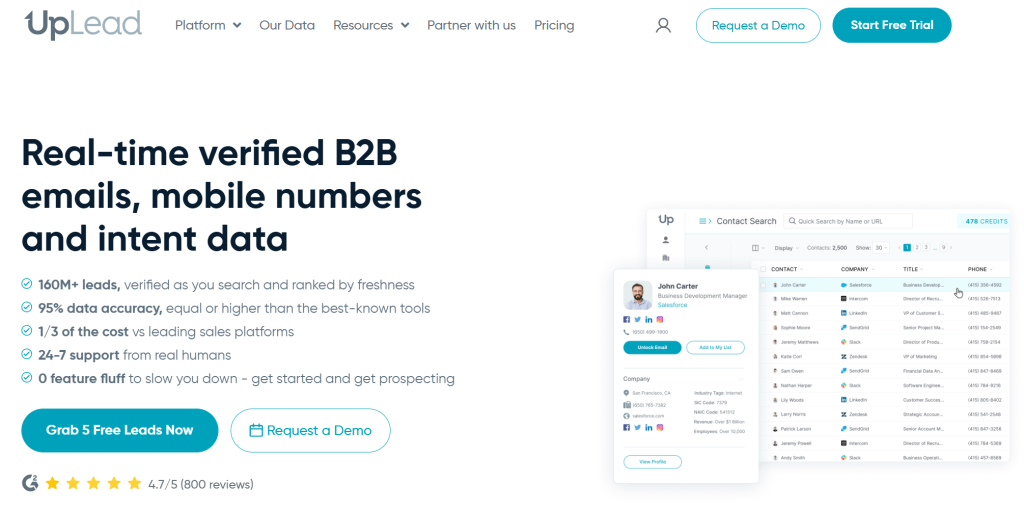
Layer multiple filters to create precision: combine job titles (VP Sales, Marketing Director) with company characteristics (50-200 employees, SaaS industry, Series B funding) and behavioral signals (hiring actively, using competitor tools).
Including the correct job title for each prospect is crucial, as it allows you to personalize your outreach and improve your cold calling effectiveness. This approach ensures you’re calling prospects who match your success patterns and have a genuine need for your solution.
You can also use your CRM data to create cold call lists by re-engaging inactive leads or opportunities that haven’t been contacted recently, making your cold outreach more targeted and effective.
Conduct Pre-Call Research to Warm Up the Call
Pre-call research transforms cold calls into warm conversations by providing specific, relevant talking points that demonstrate genuine interest in your prospect’s business.
Pre-Call Research Checklist:
- Review Internal CRM Data: Check your CRM for any prior interactions with the contact or their company. Understanding their history with your brand is the first step.
- Research the Person and Company: Visit the prospect’s LinkedIn profile to understand their role, responsibilities, recent posts, and shared connections. Review the company’s website, recent news, and press releases.
- Look for a Common Interest: Identify any common interest you share with the prospect, such as mutual connections, shared hobbies, or involvement in the same industry groups. Use this as a rapport-building point during the call.
- Identify a ‘Trigger Event’: Look for recent, specific events that create a timely reason to connect. Common trigger events include new executive hires, company funding rounds, mergers, new product launches, or significant expansion.
- Understand Role-Specific Pain Points: Tailor your value proposition to the prospect’s specific role. A CFO cares about ROI, while a Head of Sales focuses on team efficiency and revenue growth.
Personalized Opening Line Examples:
Based on a LinkedIn Post: “Hi [Name], I saw your recent post about [Topic], and your point about [Specific Insight] really resonated with me. Given your focus on [Goal], I thought you might be interested in how we’re helping other [Industry] leaders tackle [Related Challenge].”
Based on a Trigger Event: “Hi [Name], congratulations on your new role as [Title] at [Company]. Typically, when leaders step into this position, one of their early priorities is [Common Priority]. I’m reaching out because we specialize in helping with exactly that.”
Develop a Strong Mindset and Overcome Call Reluctance
Building resilience in cold calling starts by reframing rejection not as a personal failure, but as a necessary data point on the path to a ‘yes’. Even the world’s best salespeople face significant rejection, but they understand that each ‘no’ brings them statistically closer to a ‘yes’.
Detach your self-worth from call outcomes by focusing on controllable actions rather than results. You can control the number of dials, the quality of your research, and your preparation level. You cannot control whether a prospect answers, their mood, or their immediate need for your solution. Think of cold calling as a sales game—taking calculated risks, like calling during mid-afternoon, is often a good bet for improving your results and increasing your chances of connecting with prospects.
Track your improvement over time to build confidence. Monitor metrics like connection rates, conversation quality, and objection handling. Even small improvements compound over time. Remember that you grow with each call, developing skills that make you more effective and resilient.
If you’re struggling with reluctance, don’t hesitate to ask for guidance from your manager or colleagues. Almost every successful salesperson has felt the same way and can offer advice and support to help you break through this barrier.
Identify the Best Time to Make Cold Calls
Timing significantly impacts your connection rates and the quality of conversations. The best times to make cold calls vary by industry, role, and geographic location, but data reveals clear patterns for optimal calling windows. Calling during mid-afternoon is often a good bet for reaching prospects.
Generally, the highest connection rates occur during these time periods: Tuesday through Thursday between 10:00 AM – 12:00 PM and 2:00 PM – 4:00 PM in the prospect’s local time zone. Avoid Monday mornings (people are catching up from the weekend) and Friday afternoons (mental focus shifts to weekend plans).
For reaching decision makers directly, try calling outside standard business hours: before 8:30 AM, during lunch (12:00 PM – 1:00 PM), or after 5:00 PM. Senior executives often arrive early or stay late, and gatekeepers typically aren’t available during these windows.
Consider your prospect’s industry and role. Restaurant managers are best reached between 2:00 PM – 4:00 PM (after lunch rush, before dinner prep). Retail executives prefer early mornings before store operations begin. Technology leaders often have higher availability later in the day.
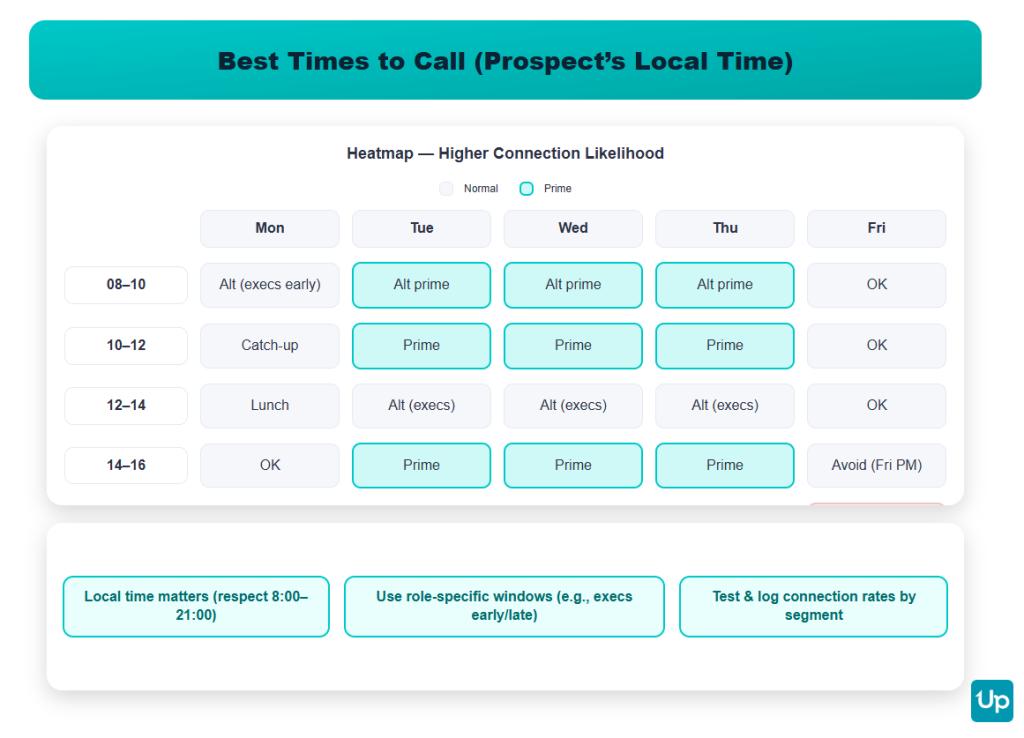
Plan Your Questions and Talking Points
Planning your questions in advance ensures you gather the information needed to move the conversation forward while maintaining a natural flow. Create a comprehensive list that covers discovery, qualification, and next steps without sounding scripted.
Structure your questions in three categories: Opening questions to build rapport and understand their current situation, Discovery questions to uncover pain points and priorities, and Qualifying questions to determine fit and decision-making process. Be sure to prepare follow up questions to encourage prospect talk, keep the conversation focused, and show that you respect the prospect’s time.
Examples of effective questions: “What’s your biggest challenge with your current [solution/process]?” “How are you currently handling [specific business function]?” “What would need to change for this to become a priority?” “Who else would be involved in evaluating a solution like these cold calling techniques?”
Prepare talking points for common scenarios: your elevator pitch, key differentiators, relevant case studies, and responses to frequent objections. Having these ready allows you to speak confidently while adapting to the conversation’s direction.
During the Call – A 6-Step Execution Framework
The actual call execution requires a structured approach that feels natural and conversational. This 6-step framework guides you through each stage while maintaining flexibility to adapt to your prospect’s responses and needs. Remember, a quick conversation or a short call can still be an effective cold call if it directly addresses the prospect’s needs and delivers value efficiently.
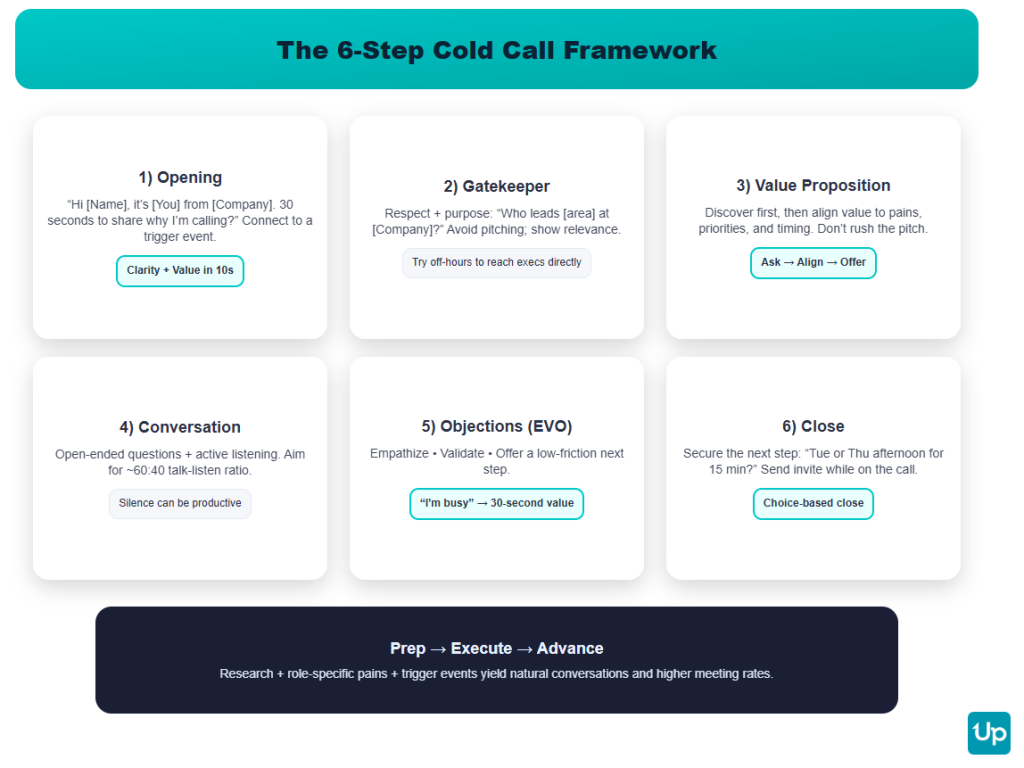
Step 1: The Opening – Craft a Compelling Opening Line
Your opening line determines whether the prospect stays on the call or hangs up immediately. A compelling opening combines politeness, clarity, and immediate value while respecting the prospect’s time.
You have 7–10 seconds to convince someone you’re worth listening to. That’s it. The best openers acknowledge the interruption (“You weren’t expecting my call…”), ask for permission (“Mind if I tell you why I’m calling?”), and use their name and something specific about them or their company.
Example: “Hi Sarah, this is Will from UpLead. You weren’t expecting my call. Mind if I take 30 seconds to explain why I’m calling, and then you can decide if we continue?” This approach is polite, confident, and puts them in control. If they say yes, you’ve already won the first micro-commitment. Mentioning your company name early in the conversation helps establish credibility and can quickly capture the prospect’s attention, making them more likely to stay engaged.
Follow immediately with your reason for calling, connecting it to their specific situation or a trigger event you discovered during research. “I noticed [Company] recently [trigger event], and I’m reaching out because we help [similar companies] [achieve specific outcome] during [similar situations].”
Avoid generic openings like “How are you today?” or “Do you have a minute to talk?” These immediately signal a sales call and trigger defensive responses. Instead, demonstrate that you’ve done your homework and have a legitimate reason for calling.
Step 2: Get Past the Gatekeeper
Treat gatekeepers as allies, not obstacles. They’re protecting their executive’s time, which means they can also help you connect with the right person when you demonstrate legitimate value.
Show respect and build rapport by addressing them by name and acknowledging their important role. “Hi [Name], I’m hoping you can help me out. I’m trying to find the right person who handles [business area] at [Company].”
Be prepared and confident when stating your purpose. Don’t pitch to the gatekeeper, but clearly explain why you need to speak with their executive. “I work with [similar companies] to help them [specific outcome], and I have some insights that might be valuable for [executive’s name] given [relevant context].”
Handle common gatekeeper objections strategically. For “Just send an email,” respond with “I’m happy to. What would be the best subject line to grab their attention?” This shows cooperation while gathering intelligence about what matters to the decision maker.
Alternative strategies include calling outside standard business hours (before 8:30 AM, during lunch, after 5 PM) when decision makers might answer directly, or using LinkedIn to connect before calling.
Step 3: The Value Proposition – Don’t Rush the Sell
Cold calling requires delicate timing. Many prospects feel uncomfortable when they perceive your call as an intrusion, so avoid rushing to your pitch. It’s important to time your sales pitch carefully—focus on building rapport and guiding the prospect toward the right solution for their needs, rather than relying on a hard sell approach. Instead, focus on understanding their situation before presenting your solution.
Too many sales reps sprint to the finish line without considering their prospects’ needs. This approach damages your success rates and closes fewer deals. The best salespeople read their prospects and see things from their perspectives before presenting solutions.
Start with discovery questions to understand their current challenges, priorities, and goals. “What’s working well with your current [process/solution]?” “What would you change if you could?” “What’s driving this to become a priority now?”
Only after understanding their situation should you present your value proposition, directly connecting your solution to their specific needs and challenges. This approach demonstrates that you’re genuinely interested in helping them, not just making a sale.
Step 4: The Conversation – Use Open-Ended Questions and Active Listening
Experienced sales reps understand that conversation is everything. While you’re engaged in an open, flowing conversation, your prospect can’t outright reject you. The key is keeping your prospect talking through strategic questioning and active listening.
Use open ended questions that require more than yes/no answers. Instead of “Are you happy with your current solution?” ask “What’s working well with your current approach, and what would you change if you could?” This keeps the conversation flowing and provides valuable information.
Give your prospect your undivided attention. Your prospect’s time is valuable, and they’ve done you a favor by taking your call. Avoid multitasking during phone calls – if you’re not properly engaged, your prospect will sense it, which could harm your customer relationship and reduce your effectiveness. Actively listening to your prospect is essential for understanding their needs and building rapport, which can significantly improve your chances of success.
Don’t worry about silence during your conversation. It can be disconcerting if your prospect doesn’t audibly respond during your pitch, but this happens more than you might realize. Some people listen this way, and you shouldn’t give up on a call because the other person isn’t responding verbally. Power through the silence and continue building value.
Step 5: Handle Objections – A 3-Step Method to Turn “No” into “Maybe”
Every salesperson encounters patterns of common objections. Rather than seeing these as roadblocks, treat them as opportunities to demonstrate value and build trust through the EVO Framework: Empathize, Validate, Offer.
How you sound matters more than what you say. If your tone is defensive, rushed, or desperate, even the best rebuttal will fail. If your tone is calm, curious, and confident, you can turn knee-jerk rejections into curiosity.
1. Empathize: Acknowledge the prospect’s statement and show understanding. This disarms them and makes them feel heard. “I completely understand that concern…”
2. Validate: Confirm that their concern is legitimate or common, building rapport and reducing defensiveness. “That’s actually something I hear from a lot of [their role/industry]…”
3. Offer: Provide a low-friction next step that addresses their validated concern, focusing on starting a conversation rather than making a sale immediately.
The “Actually… That’s Why I Called” Pivot: One line that flips resistance into curiosityfast. For “I’m not interested”: “Actually, that’s why I called. Figured you wouldn’t be interested yet, but thought you might be curious how [similar persona] are achieving [positive business outcome].” This turns disinterest into curiosity.
Specific objection examples:
For “I’m busy”: “Sounds like I caught you in the middle of something, totally understandable if now is not a good time. Do you mind if I take 30 seconds to tell you the reason for my call?”
For “Send me an email”: “I’m happy to send you an email. Is [email address] still the best way to reach you? Great. Now can you help me understand what caught your interest so I can customize the email to actually be worth your time?”
For “I’m not interested”: “I’m not trying to sell you anything today. Let me ask you: If I could show you how you can [solve specific pain point], would you be interested in finding out how?”
When handling objections, be sure to avoid common mistakes such as failing to ask follow up questions or not validating the prospect’s concerns, as these can reduce your chances of success.
Step 6: The Close – Secure the Next Step
The primary goal of a cold call is to secure the next step, not make a sale. Focus on earning the right to continue the conversation through a scheduled meeting or demonstration.
You should be closing in micro-steps the entire call. Every time you get a small “yes”, to share context, to answer a question, to hear your pitch, you’re building momentum for the final yes: the meeting.
Use low-friction, choice-based questions instead of yes/no traps. “Does Tuesday or Thursday afternoon work better for a 15-minute call?” This assumes they want to meet and simply asks for their preference on timing.
Provide clear value for the next step by connecting it to their expressed pain points. “I know you mentioned [specific challenge]. I’d love to schedule a brief meeting to show you how we’ve helped companies solve that exact issue.”
Confirm and solidify commitment by immediately sending a calendar invite while still on the phone. “I’m sending you a calendar invite right now – you should see it in your inbox in the next few minutes. Does that time still work for you?” Always make sure to schedule the next call or a follow up call before ending the conversation to maintain momentum and set expectations for the next cold call.
After the Call – Follow-Up and Automation
What happens after the call often determines whether your cold calling efforts convert into actual opportunities. Effective follow up, strategic use of technology, and smart automation can dramatically improve your results. Timely follow-ups, summarizing key takeaways from each call, and nurturing cold leads into warm leads are essential steps to build trust and increase your chances of closing a sale.
Leave a Voicemail That Gets a Call Back
Most salespeople hesitate before leaving a voicemail, but as a cold calling expert, you need to master killer voicemails that engage prospects and inspire them to call you back.
Structure your voicemail with a clear beginning, middle, and end. Start with your name and company, briefly state your reason for calling (connecting it to their specific situation), and end with a clear call to action that creates urgency or curiosity.
Keep voicemails under 30 seconds and speak clearly at a normal pace. Your CTA could be a request to call you back with a specific benefit: “Please call me back at [number] – I have some insights about [their industry/challenge] that could save you significant time and money.”
Alternatively, create curiosity without being manipulative: “I noticed something about [their company] that I think you’d find interesting. Give me a call back when you have a few minutes.” Experiment with different approaches and track which generate the highest callback rates.
Leverage Email Tracking and Collateral
Modern prospecting technology can significantly enhance your cold calling effectiveness. Work alongside your marketing colleagues to develop interesting email campaigns and activity-tracking infrastructures that support your calling efforts.
Use email tracking tools to send cold emails before your calls and monitor whether prospects open and engage with them. This intelligence helps you understand your prospects’ interest level and provides conversation starters for your calls.
Every salesperson should have a strong handle on their marketing and sales collateral. During sales calls, identify which collateral your prospect will appreciate and send it through quickly to move them further through the sales funnel.

Speed and relevance are essential when sharing resources. Consider using platforms that help you quickly share relevant case studies, ROI calculators, or industry reports that address your prospect’s specific challenges and interests.
Automate Manual Tasks to Save Time
To maximize your cold calling time, leverage various sales tools that automate manual tasks and keep you focused on high-value activities. Modern call center software and AI-powered tools can handle routine work while you focus on conversations.
Automation tools can help you with tracking prospect activity, automated dialing, categorizing and organizing prospects, scheduling meetings, and sending effective follow up emails. These tools free up significant time and mental energy for actual selling activities.
Consider platforms that offer integrated solutions for call center operations, customer relationship management, and sales engagement. Some tools even provide AI call centers that can handle initial qualification calls, allowing you to focus on the most promising prospects.
[lementor-template id=”6668″]Essential Cold Calling Tools & Technology Stack
A modern cold calling stack consists of four core components: CRM, Sales Dialer, Sales Intelligence, and Conversation Intelligence. Choosing the right combination can dramatically improve your efficiency and results. Integrating these tools streamlines sales processes and enhances team collaboration.
Your 4 core tools are Data, CRM, Dialer, and Integration. UpLead fits in as the foundation with 95% accuracy, intent data, and tech filters. Number strategy includes local presence dialing, number rotation, and avoiding spam flags. CRM workflows enable speed and follow-up automation.
CRM Platforms
Salesforce Sales Cloud offers Starter ($25/user/month), Professional ($100/user/month), Enterprise ($175/user/month), and Unlimited ($350/user/month) plans (annual billing).
HubSpot Sales Hub provides Free (2 seats), Starter ($9/seat/month on annual billing or $15 monthly), Professional ($90/seat/month on annual billing), and Enterprise ($150/seat/month) tiers. HubSpot also includes native calling with tiered minute allowances by plan.
Sales Dialers
Aircall offers Essentials (from $30/license/month on annual billing) and Professional (from $50/license/month on annual billing) plans.
Kixie provides power dialer functionality with plans typically ranging from $35–$95/user/month (billed quarterly/annually depending on tier).
Orum delivers an AI-powered Live Conversation Platform. The Launch plan starts at $250/user/month (billed annually, 3-seat minimum) with AI Parallel Dialing.
Salesfinity offers AI power and parallel dialing with straightforward pricing: Silver ($200/user/month) and Gold ($299/user/month).
We use Salesfinity for parallel dialing because it reduces idle time and keeps momentum.
Sales Intelligence
UpLead provides an accurate, comprehensive B2B database with 160M+ verified contacts, 95% email accuracy, and real-time verification—plans starting at $99/month.
ZoomInfo SalesOS generally operates on annual contracts with a typical small-team range of ~$15,000–$25,000 per year; minimum entry is commonly around $14,995/year, with optional global data add-ons.
Cognism offers comprehensive B2B sales intelligence with pricing typically starting around $15,000 annually.
Clay provides data orchestration with credit-based pricing: Free (100 credits), Starter ($149/month for 2,000 credits), Explorer ($349/month for 10,000 credits), and Pro ($800/month for 50,000 credits).
Conversation Intelligence
Gong pricing is custom, with per-user licenses plus a platform fee based on the number of supported users.
Chorus by ZoomInfo (ZoomInfo’s conversation intelligence) offers custom pricing by package and seat count.
RingCentral’s RingSense for Sales is available at about $60/user/month when bundled with RingCentral’s core suites.
Dialpad provides real-time AI transcription and sentiment analysis; Dialpad Ai plans commonly start from $15/user/month (annual billing) with higher tiers available.
All-in-One Solutions
ReadyMode provides hybrid-cloud call center software with predictive dialer and built-in CRM at transparent tiers: Starter ($199/license/month) and Readymode iQ ($249/license/month).
Klenty combines multi-channel outreach (emails, calls, LinkedIn, SMS, WhatsApp) with plans typically at Startup ($50/month), Growth ($70/month), and Pro ($100/month) on annual billing.
Specialized Tools
SalesRoads provides US-based B2B appointment setting services (17+ years in business; 4.9-star G2 rating). Pricing is customized to program scope and model.
Sellizer offers proposal tracking with transparent tiers: Early ($5/user/month), Solo ($22/user/month), and Team ($35/user/month), plus Enterprise on request.
Momentum provides AI Revenue Orchestration with Business ($69/user/month) and Transformation ($99/user/month) plans; a Note-taker add-on is available at $30/user/month.
Cold Calling FAQ
How many calls does it take to get a meeting?
The average cold calling success rate for booking meetings ranges from 2.3% to 4.82%, with data provider Salesgenie reporting approximately 4.8% success rate as of 2024. It takes an average of 6-8 attempts to reach a single prospect, meaning you might need 20-40 total calls to book one meeting. Top-quartile reps need only 8 cold calls to get one conversation, compared to 19 calls for average reps.
What’s the difference between a framework and a script?
A cold call script is word-for-word dialogue that can sound robotic and inauthentic. However, a cold calling script should serve as a flexible guide, helping salespeople navigate different conversation paths and handle objections effectively. A framework provides structured guidelines with flexibility for natural conversation. Expert Aleasha Bahr states: “The benefit of using a framework vs. a word-for-word script is it allows for flexibility and intuition. Because although there are undeniably patterns in sales – no sales call is exactly the same.”
How do you handle immediate hang-ups?
If the line goes dead, call back immediately saying “Sorry, it sounds like we got disconnected.” This gives the prospect the benefit of the doubt and often results in a second chance. If they say “Not interested” and hang up, don’t call back immediately – log the outcome and follow up later through a different channel or after a waiting period.
Master Cold Calling in 2025
Cold calling remains one of the most effective ways to generate pipeline when executed with the right cold calling strategy, tools, and mindset. By following this comprehensive framework – from legal compliance and proper preparation to AI-enhanced execution and strategic follow up – you’ll transform cold calling from a source of anxiety into your most powerful revenue generator. Implementing effective cold calling advice and strategies, such as impactful scripting, preparation, and value-driven conversations, will help you stay ahead in the sales game.
Remember that cold calling success comes from consistency, continuous improvement, and focusing on helping prospects solve real pain points. Track your metrics, refine your cold calling process, and leverage modern technology to maximize your efficiency and effectiveness.
You’ll only turn cold leads into red-hot sales opps if you’re approaching the right person and dialing active numbers. Our database of 160M+ contacts includes verified direct dials, giving our customers an edge in reaching the right people.

